The world’s biggest corporations have been riding a three-decade wave of profit growth, market expansion, and declining costs. Yet this unprecedented run may be coming to an end. Our new McKinsey Global Institute report, Playing to win: The new global competition for corporate profits, projects that the global corporate-profit pool, which currently stands at almost 10 percent of world GDP, could shrink to less than 8 percent by 2025—undoing in a single decade nearly all of the corporate gains achieved relative to the world economy during the past 30 years (exhibit).

From 1980 to 2013, vast markets opened around the world while corporate-tax rates, borrowing costs, and the price of labor, equipment, and technology all fell. The net profits posted by the world’s largest companies more than tripled in real terms from $2 trillion in 1980 to $7.2 trillion by 2013,1 pushing corporate profits as a share of global GDP from 7.6 percent to almost 10 percent. Today, companies from advanced economies still earn more than two-thirds of global profits, and Western firms are the world’s most profitable. Multinationals have benefited from rising consumption and industrial investment, the availability of low-cost labor, and more globalized supply chains.
But there are indications of a very significant change in the nature of global competition and the economic environment. While global revenue could increase by some 40 percent, reaching $185 trillion by 2025, profit growth is coming under pressure. This could cause the real-growth rate for the corporate-profit pool to fall from around 5 percent to 1 percent, practically the same share as in 1980, before the boom began. (For more, see sidebar, “The future and how to survive it,” an excerpt from a companion article in the October 2015 issue of Harvard Business Review.)
Part of the slowdown in profit growth will stem from the competitive forces unleashed by two groups of hard-charging competitors. On one side is an enormous wave of companies based in emerging economies. The most prominent have been operating as industrial giants for decades, but over the past 10 to 15 years, they have reached massive scale in their home markets. Now they are expanding globally, just as their predecessors from Japan and South Korea did before them. On the other side, high-tech companies are introducing new business models and striking into new sectors. And the tech giants themselves are not the only threat. Powerful digital platforms such as Alibaba and Amazon serve as launching pads for thousands of small and midsize enterprises, giving them the reach and resources to challenge larger companies.

Would you like to learn more about our Strategy & Corporate Finance Practice?
The competitive landscape has grown more complex, and the pace of change is accelerating. Profits are shifting from heavy industry to idea-intensive sectors that revolve around R&D, brands, software, and algorithms. Sectors such as finance, information technology, media, and pharmaceuticals—which have the highest margins—are developing a winner-take-all dynamic, with a wide gap between the most profitable companies and everyone else. Meanwhile, margins are being squeezed in capital-intensive industries, where operational efficiency has become critical.
New competitors are becoming more numerous, more formidable, and more global—and some destroy more value for incumbents than they create for themselves. Meanwhile, some of the external factors that helped to drive profit growth in the past three decades, such as global labor arbitrage and falling interest rates, are reaching their limits.
As profit growth slows, there will be more companies fighting for a smaller slice of the pie, and incumbent industry leaders cannot focus simply on defending their market niche. Our analysis of thousands of companies around the world shows that the top performers share three traits: they invest in intellectual assets, they play in fast-growing markets, and they have the most efficient operations.
Companies that adapt quickly to these new realities can capture enormous opportunities. Over the next decade, rising consumption in the emerging world will create new markets. Technology will spur new products and services. Start-ups will be able to tap global investors, suppliers, and customers with little up-front investment. But companies will face intense pressure to grow, innovate, and become more productive—not only to seize these opportunities but merely to survive.



